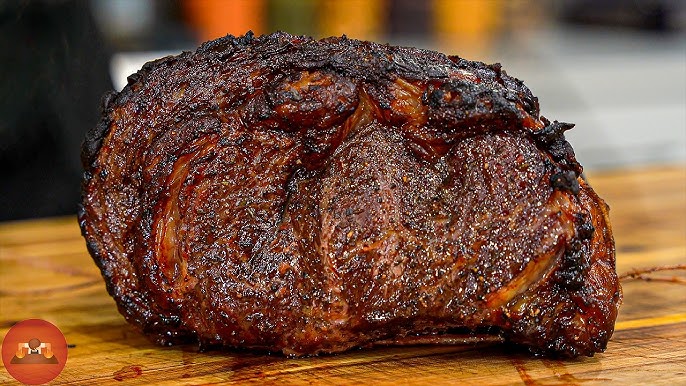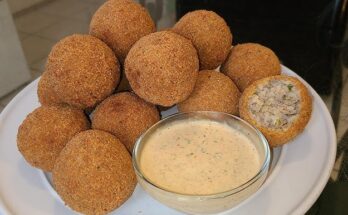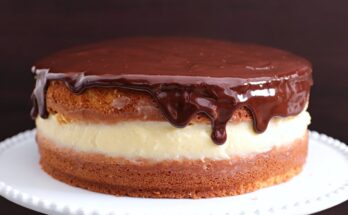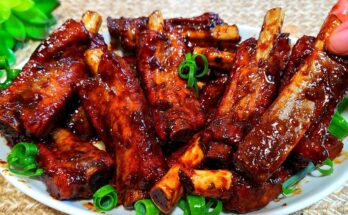Boneless Prime Rib Recipe: Nothing screams celebration like a perfectly cooked boneless prime rib. Whether it’s Christmas dinner or a family gathering, this cut of beef is known for its rich flavor, tender texture, and visual appeal. But let’s be honest—prime rib can feel intimidating. With its hefty size and premium cost, it’s the kind of dish you want to nail on the first try. That’s where this guide comes in.
This step-by-step walkthrough will help you master the boneless prime rib without stress. No fluff, just clear instructions that ensure a juicy, flavorful roast every single time. Whether you’re a seasoned home cook or a beginner, this recipe is easy to follow and guarantees rave reviews.
Ingredients You’ll Need
Getting the right ingredients is half the battle. Here’s what you’ll need to make a boneless prime rib that steals the show.
Prime Rib Cut Selection: Go for a well-marbled boneless prime rib roast. You can typically find it labeled as a “ribeye roast” at most grocery stores. Look for a cut that’s 4 to 6 pounds for a small gathering or up to 10 pounds for larger parties.
Seasoning Essentials:
- Kosher salt (generously used)
- Freshly ground black pepper
- Garlic powder
- Onion powder
- Olive oil or softened butter
Optional Flavor Boosters:
- Fresh rosemary and thyme
- Crushed garlic cloves
- Dijon mustard
- Paprika
- Smoked salt (for added depth)
Seasoning is more than just flavor—it creates that irresistible crust on the outside while locking in the juices. You can go basic with just salt and pepper or jazz it up with herbs and spices.
Tools and Equipment Required
You don’t need a commercial kitchen, but a few essential tools will make your prime rib journey smoother.
Roasting Pan vs. Cast Iron Skillet: Both options work well, but a heavy-duty roasting pan with a rack is ideal. It allows air to circulate around the meat, cooking it evenly. If you’re using a cast iron skillet, make sure it’s oven-safe and big enough to hold the roast comfortably.
Meat Thermometer Importance: This is non-negotiable. Guesswork doesn’t work with prime rib. A digital instant-read thermometer or a leave-in probe thermometer ensures your roast is perfectly cooked from edge to center.
Carving Tools: A sharp carving knife and a sturdy cutting board with grooves will help you slice the meat cleanly and safely. Don’t forget tongs for easy handling.
Preparing the Prime Rib
Preparation is everything when it comes to roasting prime rib.
Bringing to Room Temperature: Take the roast out of the fridge 2–3 hours before cooking. This step ensures even cooking and prevents a cold center. Place it on the counter, covered loosely with plastic wrap or foil.
Seasoning the Rib: Pat the roast dry with paper towels. Rub it all over with olive oil or softened butter, then generously apply your seasoning mix. Don’t be shy—prime rib is a big cut, and it can handle bold flavors. Let it sit with the seasoning while it comes to room temperature.
Tying the Roast for Even Cooking: Use kitchen twine to tie the roast in 2-inch intervals. This keeps the meat compact, which promotes even cooking and gives it a professional look. If your roast is already trimmed and uniform, this step is optional but recommended.
Cooking the Boneless Prime Rib
This is where the magic happens. Follow these instructions to ensure the meat is perfectly pink and tender.
Oven Temperature and Time Guide: Start your oven at 450°F (232°C) for the first 20 minutes to get a beautiful crust. Then, reduce the temperature to 325°F (163°C) and continue roasting.
Use the following internal temperature guide:
- Rare: 120°F (49°C)
- Medium-Rare: 130°F (54°C)
- Medium: 135°F (57°C)
General Timing Estimate:
- For medium-rare: Cook about 15–20 minutes per pound.
- A 5-pound roast = roughly 1 hour 15 minutes (plus resting time)
Reverse Sear vs. Traditional Method: The traditional method (high heat followed by lower heat) is great for a well-developed crust. The reverse sear (low and slow, then a blast of heat at the end) gives more control over doneness and an even pink center. Choose what works best for your style.
Checking Internal Temperature: Insert the thermometer into the thickest part of the roast. Make sure it’s not touching bone or fat for an accurate read. Once it hits your target temp, remove the roast immediately.
Let it rest for at least 30 minutes under foil. This lets the juices redistribute, so you won’t lose them all when slicing.
Letting the Meat Rest and Carve
Resting might seem like a passive step, but it’s absolutely essential. Think of it like a cool-down after a workout—skipping it can be disastrous.
Why Resting Is Non-Negotiable: When you remove the prime rib from the oven, the juices inside are still bubbling and looking for an escape route. If you slice the roast immediately, all those delicious juices will pour out onto your cutting board instead of staying inside the meat. By letting it rest for at least 30 minutes, the juices redistribute evenly, resulting in a moist, tender bite every time.
How to Rest It Right: Tent the roast loosely with aluminum foil. Don’t wrap it tightly—that traps steam and can soften the crust. Just lay the foil over the top and let the meat sit on a cutting board or a warm platter.
Slicing the Prime Rib: Use a sharp carving knife and cut against the grain into thick slices, about 1/2 to 3/4 inch thick. Cutting against the grain ensures each bite is tender. Serve the slices immediately while they’re warm and juicy.
Pro tip: If you want restaurant-style presentation, slice only what you need and keep the rest whole. This helps retain heat and juiciness for seconds—or thirds!
Serving Suggestions
The star of the show deserves worthy co-stars. Let’s talk about what pairs well with boneless prime rib.
Classic Side Dishes:
- Creamy mashed potatoes or garlic herb roasted potatoes
- Yorkshire pudding (a British classic!)
- Green beans almondine or sautéed asparagus
- Horseradish cream sauce or au jus
- Caesar salad with crunchy croutons
Wine Pairings: Red wine is your best friend here. Choose bold reds like:
- Cabernet Sauvignon
- Merlot
- Syrah
- Zinfandel
These wines have the structure to complement the richness of the prime rib without overpowering it.
Pro Tip: Warm the plates before serving. A hot meal on a warm plate keeps the prime rib from cooling too quickly at the table.
Storing Leftovers Properly
Let’s face it—leftovers from prime rib might be rare (pun intended), but if you’re lucky enough to have some, they deserve to be treated right.
Refrigeration: Slice and store leftover meat in an airtight container in the fridge. It’ll stay good for up to 4 days. For added flavor, store it with any leftover jus or drippings.
Freezing: Wrap slices in plastic wrap, then place them in a zip-lock bag or vacuum-seal them. They’ll last in the freezer for up to 3 months.
Reheating Tips: The trick is to reheat gently without overcooking:
- Oven: Place slices in a baking dish, cover with foil, and warm at 250°F until heated through.
- Stovetop: Reheat gently in a covered skillet with a splash of beef broth.
Avoid the microwave unless you’re desperate—it can dry out the meat fast.
FAQs about Boneless Prime Rib Recipe
1. Can I cook boneless prime rib from frozen?
No, it’s best to thaw the roast completely in the refrigerator for 2–3 days before cooking to ensure even doneness and food safety.
2. What’s the difference between prime rib and ribeye?
Both come from the same section of the cow. Prime rib is a large roast, often slow-cooked, while ribeye is typically sliced into steaks and grilled or pan-seared.
3. Do I need to marinate the prime rib?
No, marinating isn’t necessary for prime rib. A good seasoning rub and proper cooking technique are enough to enhance the meat’s natural flavor.
4. How do I get a better crust on the roast?
Start at a high oven temperature (450°F) for the first 20 minutes, then reduce heat. Make sure the surface is dry before seasoning to promote better browning.
5. Can I use this recipe for a bone-in prime rib?
Absolutely! Just adjust the cooking time slightly—bone-in roasts often take a bit longer but add extra flavor.
Conclusion
Cooking a boneless prime rib may sound intimidating at first, but once you break it down, it’s surprisingly simple. With the right ingredients, tools, and a bit of patience, you’ll be serving up a restaurant-quality roast that’ll have everyone raving. Whether you’re hosting a holiday dinner or just want to treat yourself and your loved ones to something special, this prime rib recipe is a guaranteed hit.
So, what are you waiting for? Grab that gorgeous cut of beef and let’s get cooking—because once you’ve tasted perfectly done boneless prime rib, there’s no going back.



